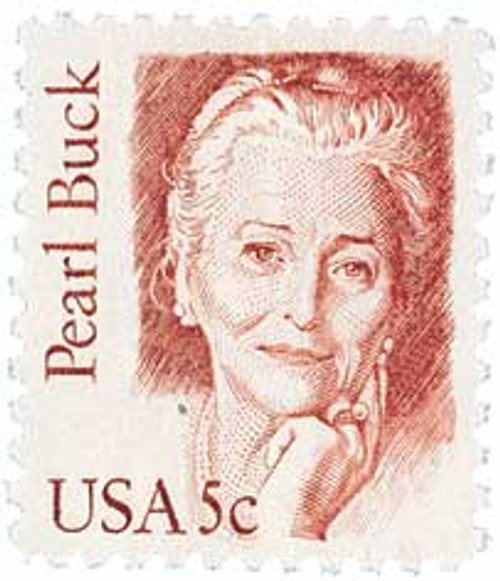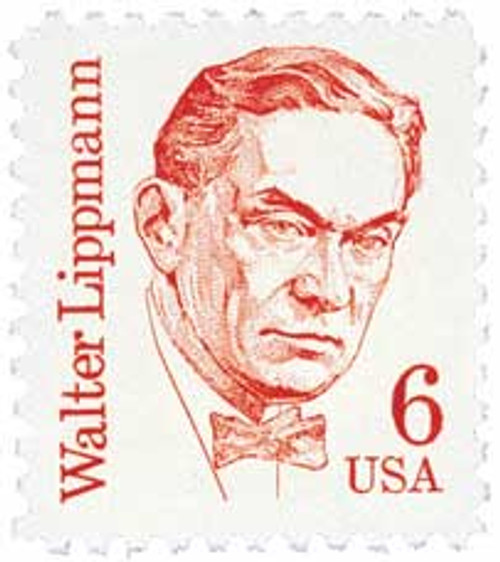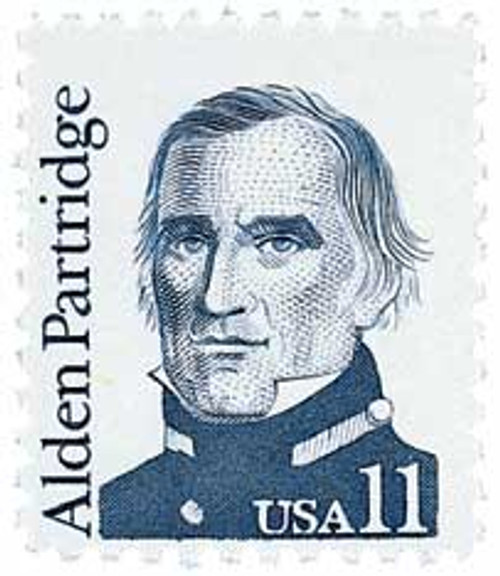
# 2936 - 1998 32c Great Americans: Lila and DeWitt Wallace
US #2936
1998 Lila and DeWitt Wallace
- 61st stamp in Great Americans series
- Second stamp in series issued in 1998
- Honors founders of Reader’s Digest
- Only stamp in series to picture two people
Category of Stamp: Definitive
Set: Great Americans
Value: 32¢, First Class Mail rate
First Day of Issue: July 16, 1998
First Day City: Pleasantville, New York
Quantity Issued: 30,250,000
Printed by: Ashton-Potter (USA) Ltd.
Printing Method/Format: Engraved. Panes of 20 from plates of 240 (15 across, 16 down)
Perforations: 11.2
Color: Blue
Reason the stamp was issued: This stamp is part of the Great American series. It honors Lila and DeWitt Wallace, founder of Reader’s Digest magazine and philanthropists.
About the stamp design: The Wallace stamp is the only issue in the Great Americans series to picture two people. Paul Calle was the artist behind the Lila and DeWitt Wallace stamp. He is best known for his 1969 Moon Landing stamp. He also illustrated many articles in Reader’s Digest. Calle used a 1954 photo of the couple as inspiration for his illustration. The design for the stamp was first revealed in Reader’s Digest magazine.
Special design details: Though known as founders and publishers of the popular magazine, DeWitt and Lila preferred to be known for the charities they supported. The word “Philanthropists” was chosen for the stamp instead of “Publishers.”
First Day City: The First Day of Issue ceremony took place at the DeWitt Wallace Auditorium in Pleasantville, New York. This town was location of the headquarters of Reader’s Digest.
About the Great American Series:
The Great Americans Series was created to replace the Americana Series. The new series would be characterized by a standard definitive size, simple design, and monochromatic colors.
This simple design included a portrait, “USA,” the denomination, the person’s name, and in some cases, their occupation or reason for recognition. The first stamp in the new series was issued on December 27, 1980. It honored Sequoyah and fulfilled the new international postcard rate that would go into effect in January 1981.
The Great Americans Series would honor a wider range of people than the previous Prominent Americans and Liberty Series. While those series mainly honored presidents and politicians, the Great Americans Series featured people from many fields and ethnicities. They were individuals who were leaders in education, the military, literature, the arts, and human and civil rights. Plus, while the previous series only honored a few women, the Great Americans featured 15 women. This was also the first definitive series to honor Native Americans, with five stamps.
The Bureau of Engraving and Printing (BEP) produced most of the stamps, but private firms printed some. Several stamps saw multiple printings. The result was many different varieties, with tagging being the key to understanding them. Though there were also differences in perforations, gum, paper, and ink color.
The final stamp in the series was issued on July 17, 1999, honoring Justin S. Morrill. Spanning 20 years, the Great Americans was the longest-running US definitive series. It was also the largest series of face-different stamps, with a total of 63.
History the stamp represents:
DeWitt Wallace (1889-1981) was wounded while serving in the US Army during World War I. While recovering in a Frech hospital, he was inspired to create a magazine that condensed longer magazine articles into short, easy-to-read articles. Wallace returned to US and showed a sample of his idea to Lila Bell Acheson, the sister of a college friend. Not only did she like the article, she soon agreed to marry DeWitt.
The Wallaces tried to find a publisher for the new magazine, but no one was interested. They moved to New York and began publishing Reader’s Digest themselves. The first issue was released February 5, 1992, and circulation grew quickly. They established their headquarters in Pleasantville, New York, a suburb of New York City. From there, they produced what became one of the most popular magazines in the world.
DeWitt and Lila shared their financial success, donating millions of dollars during their lifetime. Their generosity benefitted education, arts, music, and more. The Wallaces helped improve Colonial Williamsburg, the Metropolitan Museum of Art, the New York Public Library, and much more. Even after their deaths, their money continued to fund charities through the DeWitt Wallace-Reader’s Digest Fund and the Lila Wallace-Reader’s Digest Fund.
US #2936
1998 Lila and DeWitt Wallace
- 61st stamp in Great Americans series
- Second stamp in series issued in 1998
- Honors founders of Reader’s Digest
- Only stamp in series to picture two people
Category of Stamp: Definitive
Set: Great Americans
Value: 32¢, First Class Mail rate
First Day of Issue: July 16, 1998
First Day City: Pleasantville, New York
Quantity Issued: 30,250,000
Printed by: Ashton-Potter (USA) Ltd.
Printing Method/Format: Engraved. Panes of 20 from plates of 240 (15 across, 16 down)
Perforations: 11.2
Color: Blue
Reason the stamp was issued: This stamp is part of the Great American series. It honors Lila and DeWitt Wallace, founder of Reader’s Digest magazine and philanthropists.
About the stamp design: The Wallace stamp is the only issue in the Great Americans series to picture two people. Paul Calle was the artist behind the Lila and DeWitt Wallace stamp. He is best known for his 1969 Moon Landing stamp. He also illustrated many articles in Reader’s Digest. Calle used a 1954 photo of the couple as inspiration for his illustration. The design for the stamp was first revealed in Reader’s Digest magazine.
Special design details: Though known as founders and publishers of the popular magazine, DeWitt and Lila preferred to be known for the charities they supported. The word “Philanthropists” was chosen for the stamp instead of “Publishers.”
First Day City: The First Day of Issue ceremony took place at the DeWitt Wallace Auditorium in Pleasantville, New York. This town was location of the headquarters of Reader’s Digest.
About the Great American Series:
The Great Americans Series was created to replace the Americana Series. The new series would be characterized by a standard definitive size, simple design, and monochromatic colors.
This simple design included a portrait, “USA,” the denomination, the person’s name, and in some cases, their occupation or reason for recognition. The first stamp in the new series was issued on December 27, 1980. It honored Sequoyah and fulfilled the new international postcard rate that would go into effect in January 1981.
The Great Americans Series would honor a wider range of people than the previous Prominent Americans and Liberty Series. While those series mainly honored presidents and politicians, the Great Americans Series featured people from many fields and ethnicities. They were individuals who were leaders in education, the military, literature, the arts, and human and civil rights. Plus, while the previous series only honored a few women, the Great Americans featured 15 women. This was also the first definitive series to honor Native Americans, with five stamps.
The Bureau of Engraving and Printing (BEP) produced most of the stamps, but private firms printed some. Several stamps saw multiple printings. The result was many different varieties, with tagging being the key to understanding them. Though there were also differences in perforations, gum, paper, and ink color.
The final stamp in the series was issued on July 17, 1999, honoring Justin S. Morrill. Spanning 20 years, the Great Americans was the longest-running US definitive series. It was also the largest series of face-different stamps, with a total of 63.
History the stamp represents:
DeWitt Wallace (1889-1981) was wounded while serving in the US Army during World War I. While recovering in a Frech hospital, he was inspired to create a magazine that condensed longer magazine articles into short, easy-to-read articles. Wallace returned to US and showed a sample of his idea to Lila Bell Acheson, the sister of a college friend. Not only did she like the article, she soon agreed to marry DeWitt.
The Wallaces tried to find a publisher for the new magazine, but no one was interested. They moved to New York and began publishing Reader’s Digest themselves. The first issue was released February 5, 1992, and circulation grew quickly. They established their headquarters in Pleasantville, New York, a suburb of New York City. From there, they produced what became one of the most popular magazines in the world.
DeWitt and Lila shared their financial success, donating millions of dollars during their lifetime. Their generosity benefitted education, arts, music, and more. The Wallaces helped improve Colonial Williamsburg, the Metropolitan Museum of Art, the New York Public Library, and much more. Even after their deaths, their money continued to fund charities through the DeWitt Wallace-Reader’s Digest Fund and the Lila Wallace-Reader’s Digest Fund.





















